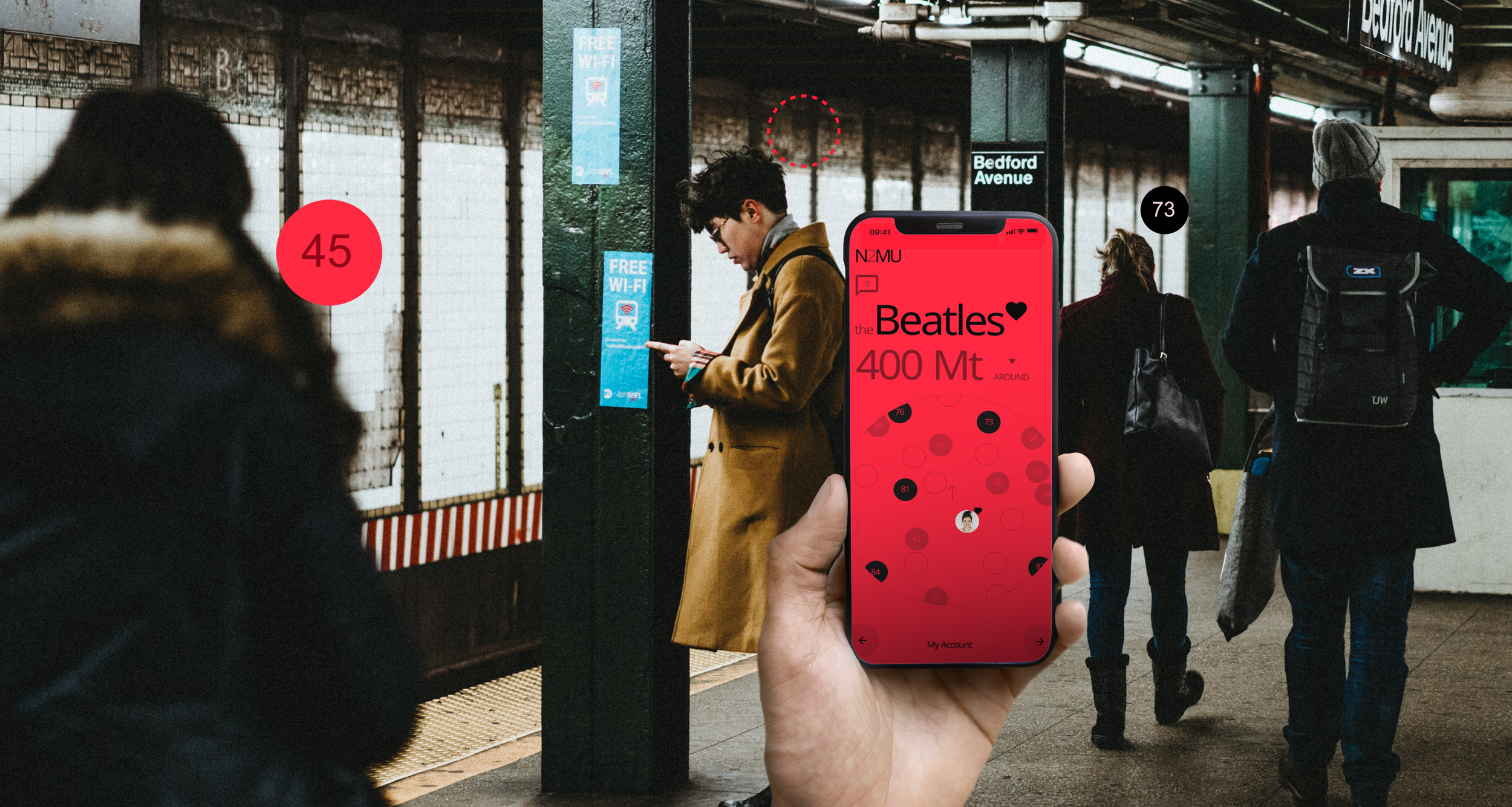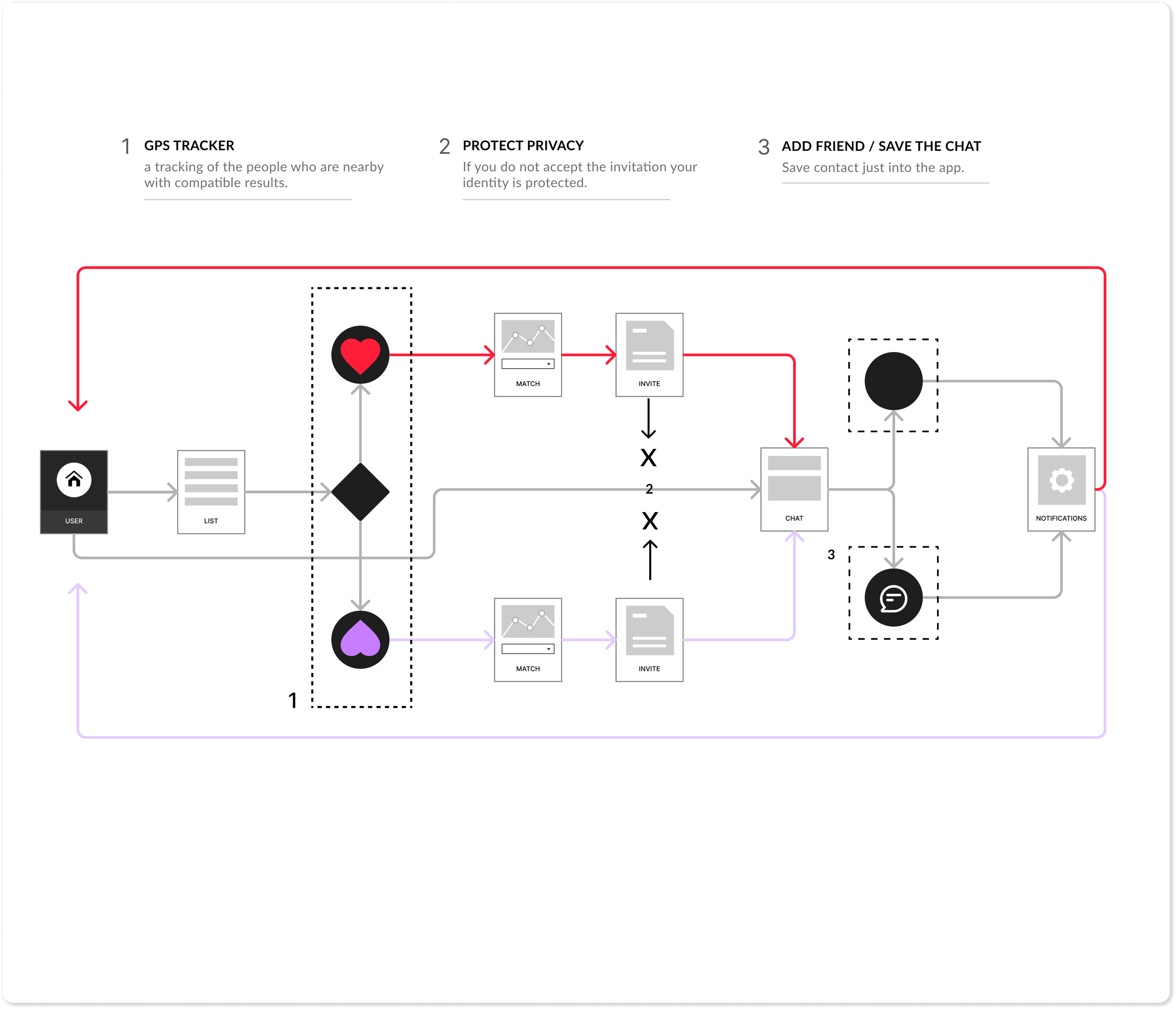
As a UX Researcher and UI Designer, I understand the importance of creating meaningful connections through technology. N2MU is designed to solve the problem of feeling isolated in crowded public spaces. Utilizing advanced UX research techniques, the application is capable of detecting the preferences and interests of nearby individuals and comparing them to your own. This not only provides the opportunity for a facilitated first interaction, but also the potential for a deeper connection. For example, if the app detects someone nearby who shares your love for The Beatles and another who shares your aversion to the conflict in the UK, these commonalities can serve as a starting point for a conversation that may lead to a face-to-face encounter.
Project Overview
Project duration:
September 2022 until now
The problem:
I am passionate about bridging the gap between technology and human connection. The issue at hand is that technology has created a physical distance between individuals in public spaces, as they are often occupied with device-mediated interactions.
The goal:
The goal of our project is to design an app that promotes real-time and physical interaction between individuals when they are in the same place. Through the utilization of cutting-edge UX research methods and analytics, we aim to restore the power of socialization to society, harnessing technology as a tool for bringing people together, not further apart.
My role:
UX designer designing an app for Black Bones from conception to delivery.
The product:
N2MU is a cutting-edge smartphone application designed to enhance the socialization experience. As a Senior UX Researcher and UI Designer, I have developed a user-centered approach that leverages GPS technology and data analysis to match individuals with similar preferences and interests. Users are able to register their likes and dislikes through an intuitive list-based system, and N2MU then uses this information to identify potential connections within close proximity. Through in-app messaging, users can initiate conversations and potentially escalate the interaction to an in-person encounter. N2MU is a prime example of how UX research and design principles can lead to the development of innovative and effective solutions.
Responsibilities:
Conduct User Research to Explore Social Network Behavior
Formulate Hypotheses Based on User Input
Conduct In-Depth Interviews and User Tests
Analyze Data to Identify Trends and Insights
Develop Paper and Digital Wireframes
Create Low- and High-Fidelity Prototypes
Conduct Usability Studies to Assess User Experience
Ensure Accessibility Compliance throughout the Design Process
Continuously Iterate on Designs, Incorporating Responsive Design Principles
Understanding the user
User research
Personas
Problem statements
User journey maps
User research: summary
Key Findings:
Decline in Face-to-Face Socialization: Survey research on face-to-face socialization in the last decade revealed a pattern of decline. In 2022, individuals were found to be socializing 5 hours less per day compared to the previous year. This trend is potentially due to the pandemic, however, a decrease in face-to-face socialization has been observed since 2012. The research also indicated an increasing rate of depression and suicides globally.
Digital Absorption and Loneliness: Empathy mapping and user interviews revealed that a primary user group identified through the research, which comprises individuals who interact in public places, is facing increasing loneliness and are absorbed in their digital devices. The research indicated a need for a mechanism to connect individuals in public places.
Need for a Connection Bridge: The research confirmed the need for an application that could serve as a bridge between strangers in public or nearby places, providing a pretext to initiate a conversation.
Implications:
These findings highlight the importance of designing user-centered solutions that address the needs of individuals facing loneliness and the decline in face-to-face socialization. As a UX Researcher and UI Designer, it is crucial to consider the impact of digital devices on social interactions and create design solutions that foster human connection in public places.
PAIN POINTS
Device Immersion in Public Places:
Findings suggest that people in public places tend to be more absorbed in their digital devices, causing a decline in face-to-face socialization.
Loneliness in Urban Environments:
Despite being in large cities with a high concentration of individuals, people are increasingly feeling lonely and are socializing less with unknown individuals in person.
Fear of Interacting with Strangers:
There is a growing fear of interacting with strangers in the general population, leading to distrust of individuals who are not part of their immediate social circle.
Lack of Socialization Skills:
The rise of social media has caused the new generations to lose the ability to initiate conversations with strangers, leading to a need for tools that facilitate social interaction in public places.
personas
Three types of people were developed, based on the studies carried out in the preliminary investigation:
Socializing Seekers: Participants who express a desire to expand their social network and engage in face-to-face interaction.
Opinion Oriented: Participants who seek to understand their community's perspectives and compare their own thoughts.
Network Builders: Participants who use the platform with the intent to build relationships and strengthen their existing social network.
The research findings indicate that there are distinct user personas, each with unique behaviors, motivations, and goals. By understanding these personas, the UX team can design an experience that meets their specific needs and enhances their overall user experience.
USER JOURNEY MAP
Our research on the specialized UX process has revealed that the journey map was critical in our understanding of the process of connecting individuals with unknown people. By focusing on the journey map, we aimed to identify the key factors that either facilitated or hindered the interaction process for both those seeking new connections and those approached.
Through our research, we found that negative emotions such as grief, fear, and shame were major barriers for individuals attempting to initiate the interaction process. On the other hand, individuals approached expressed a lack of trust, fear, and concern for privacy invasion, which also hindered the interaction process.
The journey map for this project was developed through comparative analysis and research studies on the attitudes and behaviors of individuals aged 20 to 45 towards in-person socialization with strangers. The findings indicated that these individuals held aspirational views towards meeting new people but had limited real-life experience.
To gain insights into their behaviors, the team conducted qualitative research to understand the common mechanisms that hindered or facilitated the process of connecting with others. The findings revealed that grief, fear, and shame were some of the key obstacles to initiating social interactions, while distrust, fear of invasion of privacy, and lack of confidence were common barriers to accepting social advances.
Based on these findings, the team identified several opportunities for designing a user-centered experience, including providing ways for individuals to join clubs, attend events, participate in community service activities, take classes, or initiate conversations in public spaces.
PROBLEM STATEMENT
Shawn is a musician who needs to travel constantly and meets strangers in many places, this has made him realize that the ability to socialize in person has been largely replaced by digital devices and that the mechanisms to meet strangers It is increasingly complicated by social issues of this new era.
Shawn wants an app that gives him the opportunity to create a new bridge with strangers who are physically in the same place as him, so he can create encounters with strangers.
Starting the design
Sitemap
Paper wireframes
Digital wireframes
Low-fidelity prototype
Usability studies
site map
version 3.a
Texas, USA
The site map was created with a user-centered approach to ensure a seamless flow of information and interactions. Our goal was to facilitate the connection between two strangers by providing a common ground or shared interests. By designing a simple and intuitive interface, we aimed to foster the development of organic relationships between users and remove any barriers that might hinder the process of getting to know each other. The final decision to continue the relationship was left up to the users, ensuring a user-driven experience.
paper wireframes
A
The key focus was on the application's radar feature, which allows users to visualize their compatibility levels with other users in their proximity. The app's title, incorporating hashtags of likes and dislikes, effectively showcases the user's preferences and enhances the overall user experience.
B
To ensure a successful wireframing process, various UX research methodologies were employed, including user interviews, prototyping, and usability testing. The results of these studies informed the development of low and high-fidelity wireframes, which were then iterated upon to optimize the user experience.
Accessibility was also a crucial consideration throughout the design process, ensuring that the app is usable for a wide range of users. The final wireframe design incorporated responsive design principles, ensuring optimal user experience across a variety of devices and screen sizes.
digital wireframes
Our initial design concept for N2MU aimed to provide a simple and minimalist interface, prioritizing ease of use and intuitive navigation for users. However, upon conducting usability studies, we realized that the half ring design for switching between likes and dislikes was not user-friendly.
To address this, we iterated on the design to create a more user-centered solution. We incorporated the ability to expand the radar diameter to allow users to control the proximity of potential matches. Additionally, we placed a strong emphasis on data privacy and security, ensuring that users have control over their data and the ability to accept or reject detected users.
Usability study
PARAMETERS
Study type:
Moderated usability study
Location:
United States, Remote
Participants:
10 persons
Length:
10-20 minutes
FINDINGS
The Heart Icon:
Our initial design included a heart icon as a new type of hashtag, which received mixed reactions from users. Some loved the idea, while others rejected the dislike icon, perceiving it as a symbol of anger or frustration. To address this feedback, we decided to retain the heart icon and explore alternative placement options
The Power of Simplicity:
The flat design was well-received by users, who appreciated its simplicity and ease of interaction. However, during user testing, we identified areas for improvement in the user journey and made modifications accordingly.
Emphasizing the Hashtag:
Our research revealed that users felt a sense of ownership and creativity when creating their own hashtags. To capitalize on this sentiment, we determined that the hashtag should be given greater prominence on the screen.
Streamlining the User Journey:
We recognize that when users are trying out a new app, they prefer a streamlined process with minimal options to avoid complexity. To that end, we focused on simplifying the user journey to ensure a seamless and enjoyable experience.
Refining the design
Mockups
High-fidelity prototype
Accessibility
RESULTS CASE STUDIES
R1
R 2
R 3
Proto flow
proms screen variations
PROMOs
prototype
At the moment the prototype is still in the first iteration phase, the survey has not yet yielded practical results, the development process is still in the testing phase.
Going forward
Takeaways
Next steps
takeaways
IMPACt:
Our objective is to design a user-friendly and engaging application that is perceived as credible and valuable in its intended usage. To achieve this, we aim to streamline the user journey, ensuring that the review process takes no more than 8 seconds and the chat process no more than 15 seconds.
WHAT I LEARNED:
Human capacity to socialize and empathize with others is a crucial aspect of our evolution that has taken millions of years to develop. The lack of meaningful connections with those around us can lead to feelings of loneliness and a decreased understanding of the needs of others.
USER RESEARCH
To better understand user behavior and socialization, we plan to conduct field research with a controlled group of 100 individuals in a small, tourist-oriented town
NEXT STEPS
COMPATIBILITY TESTING
We will test the app in crowded social environments, such as pubs and parks, and compare the results to less conventional sites, such as subways and airports, through an AB testing method.
BETA TESTING
We will develop a beta version of the app to be integrated into the digital devices of a representative sample of at least 10% of the population in three different towns. We will monitor behavior, usability, and pain points for a minimum of 3 months.




















